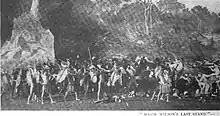Major Wilson's Last Stand
Major Wilson's Last Stand is an 1899 British silent short war film based upon the historical accounts of the Shangani Patrol. The film was adapted from Savage South Africa, a stage show depicting scenes from both the First Matabele War and the Second Matabele War which opened at the Empress Theatre, Earls Courte, on 8 May 1899.[3] It was taken on the field by Joseph Rosenthal for the Warwick Trading Co., Ltd.[4] Copies of this short film originally sold for £3.
| Major Wilson's Last Stand | |
|---|---|
 Photo by Frederic G. Hodsoll depicting the final scene of Savage South Africa, the play on which the film was based | |
| Screenplay by | Frank E. Fillis [1] |
| Based on | Historical events of the Shangani Patrol (1893) |
| Starring | Texas Jack Peter Lobengula Francis "Frank" Edward Fillis |
Production company | Levi, Jones & Company |
Release date | September 1899 (UK) |
Running time | 125 ft.[2] |
| Country | United Kingdom |
| Language | Silent English intertitles |
The film was shown to audiences at the Olympic Theatre in London and at the Refined Concert Company in New Zealand.
Story
The studio's original description is as follows:
"Major Wilson and his brave men are seen in laager in order to snatch a brief rest after a long forced march. They are suddenly awakened by the shouts of the savages, who surround them on all sides. The expected reinforcements alas arrived too late. The Major calls upon his men to show the enemy how a handful of British soldiers can play a losing game as well as a winning one. He bids them to stand shoulder to shoulder, and fight and die for their Queen. The horses are seen to fall, and from the rampart of dead horses, the heroic band fight to the last round of revolver ammunition. The Major, who is the last to fall, crawls to the top of the head of dead men, savages and horses, and makes every one of the few remaining cartridges find its mark until his life is cut short by the thrust of an assegai in the hands of a savage, who attacks him from behind. Before he falls however, he fires his last bullet into the fleeing carcass of the savage, who drops dead. The Major also expires, and death like silence prevails. The most awe-inspiring cinematograph picture ever produced."[5]
Cast
- Texas Jack as Frederick Russell Burnham, the American Chief of Scouts[6]
- Peter Lobengula (the son of the real-life Matabele King) as King Lobengula[7]
- Francis "Frank" Edward Fillis as Major Allan Wilson[8]
- Cecil William Coleman as Captain Greenless[9]
- Ndebele warriors—played by Zulu predominantly from the Colony of Natal.[10]
See also
- Shangani Patrol (film) – The historical full-length feature film shot on location in Rhodesia and released in 1970.
References
- Frank E. Fillis – IMDb.
- Barnes, John (1990). Filming the Boer War. Beginnings of the cinema in England, 1894-1901, v. 4. London : Bishopgate. p. 265. ISBN 1852190469.
- MacKenzie, John M (1986). Imperialism and popular culture. Manchester, UK: Manchester University Press. p. 97.
- "Theater Royal Timaru". Timaru Herald. New Zealand. LXIV (3220): 1. 26 March 1900.
- Authur C. Brookes, ed. (December 1899). "Films". The Photographic Dealer and Optical and Scientific Apparatus Trades Journal. London, England. VII (43): 147.
- Barrett, Cathy J.; Heather Valiance (October 1999). "The wild west show: socio-historic spectacle and characters as circus". Australasian Drama Studies: 125.
- Shephard, Ben (2003). Kitty and the prince. London. ISBN 1861975104.
- Jackie (17 February 2011). "Talented circus man with big ideas spared no cost on putting on a good spectacle". Cape Argus (South Africa): 15.
- "Week by Week". Bulawayo Chronicle (Bulawayo, Zimbabwe): 2. 9 December 1922.
- MacKenzie, John M. (1986). Imperialism and Popular Culture. Manchester, UK: Manchester University Press. p. 98.